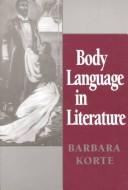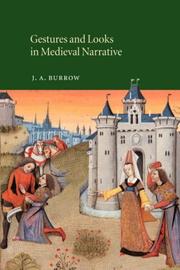| Listing 1 - 2 of 2 |
Sort by
|

ISBN: 0802076564 0802007066 9786612003202 1282003208 1442671491 9781442671492 9780802007063 9780802076564 Year: 1998 Publisher: Toronto
Abstract | Keywords | Export | Availability | Bookmark
 Loading...
Loading...Choose an application
- Reference Manager
- EndNote
- RefWorks (Direct export to RefWorks)
In Body Language in Literature, Barbara Korte has produced an important interdisciplinary study, by establishing a general theory that accounts for the varieties of body language encountered in literary narrative, based on a general history of the phenomenon in the English language. By focusing on major works of literature, including stories by D.H. Lawrence, Margaret Atwood, and J.D. Salinger, Korte shows body language to be a vital yet unexplored method of communication in literature.
Body language in literature. --- English fiction --- Human body in literature. --- Nonverbal communication in literature. --- History and criticism. --- -Nonverbal communication in literature --- Body language in literature --- Body, Human, in literature --- 82.04 --- #SBIB:012.AANKOOP --- #SBIB:309H53 --- 82.04 Literaire thema's --- Literaire thema's --- Nonverbal communication (Psychology) in literature --- Human figure in literature --- English literature --- History and criticism --- Niet-verbale communicatie --- Human body in literature --- Nonverbal communication in literature

ISBN: 1107134129 0521050669 0511147937 0511325754 0511120737 0511483244 1280159707 0511045808 0511016662 9780511016660 9780511045806 9780511120732 9780521815642 0521815649 9780511483240 9781280159701 9780521050661 9781107134126 9780511147937 9780511325755 Year: 2002 Publisher: Cambridge, UK New York Cambridge University Press
Abstract | Keywords | Export | Availability | Bookmark
 Loading...
Loading...Choose an application
- Reference Manager
- EndNote
- RefWorks (Direct export to RefWorks)
In medieval society, gestures and speaking looks played an even more important part in public and private exchanges than they do today. Gestures meant more than words, for example, in ceremonies of homage and fealty. In this, the first study of its kind in English, John Burrow examines the role of non-verbal communication in a wide range of narrative texts, including Chaucer's Troilus and Criseyde, the anonymous Sir Gawain and the Green Knight, Malory's Morte D'arthur, the romances of Chrétien de Troyes, the Prose Lancelot, Boccaccio's Il Filostrato, and Dante's Commedia. Burrow argues that since non-verbal signs are in general less subject to change than words, many of the behaviours recorded in these texts, such as pointing and amorous gazing, are familiar in themselves; yet many prove easy to misread, either because they are no longer common, like bowing, or because their use has changed, like winking.
Literature, Medieval --- Nonverbal communication in literature. --- History and criticism. --- Narration (Rhetoric) --- History --- Arts and Humanities --- Literature --- Rhetoric --- Discourse analysis, Narrative --- Narratees (Rhetoric)
| Listing 1 - 2 of 2 |
Sort by
|

 Search
Search Feedback
Feedback About UniCat
About UniCat  Help
Help News
News